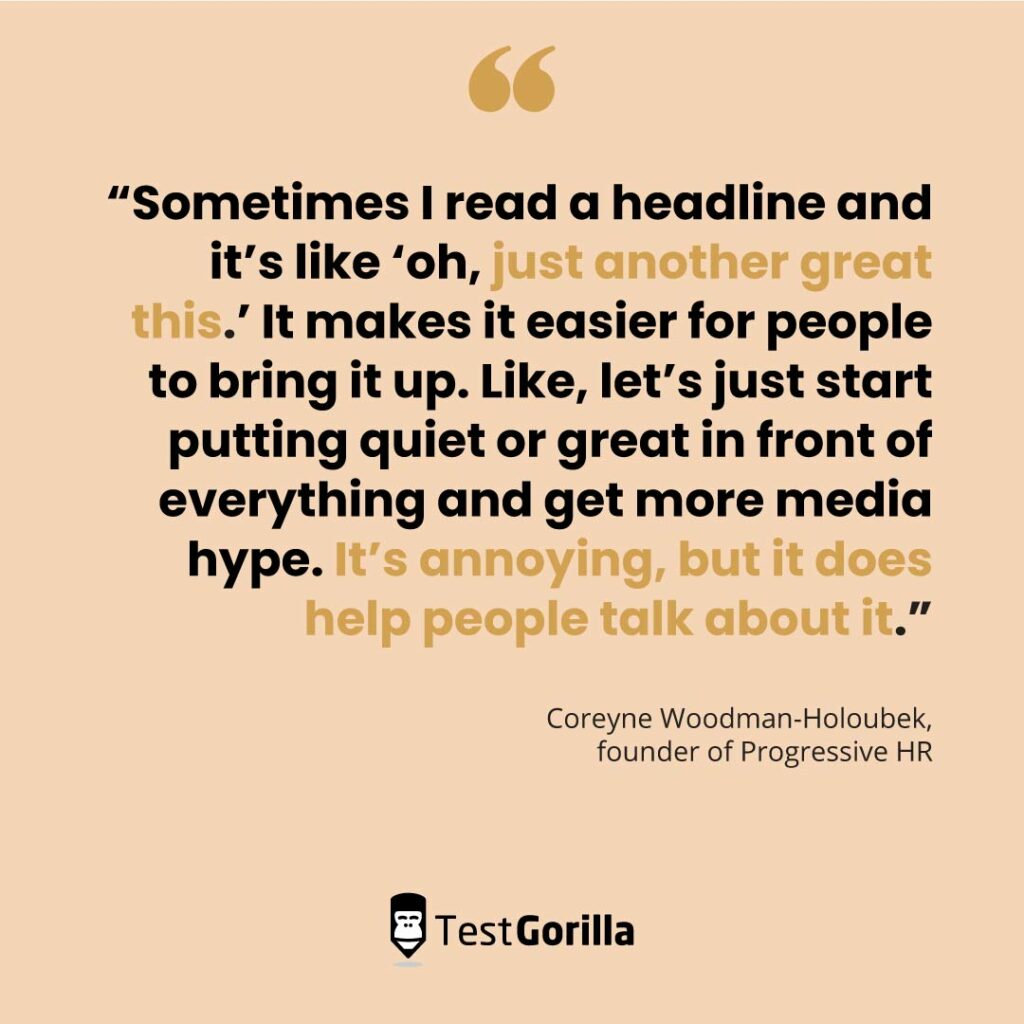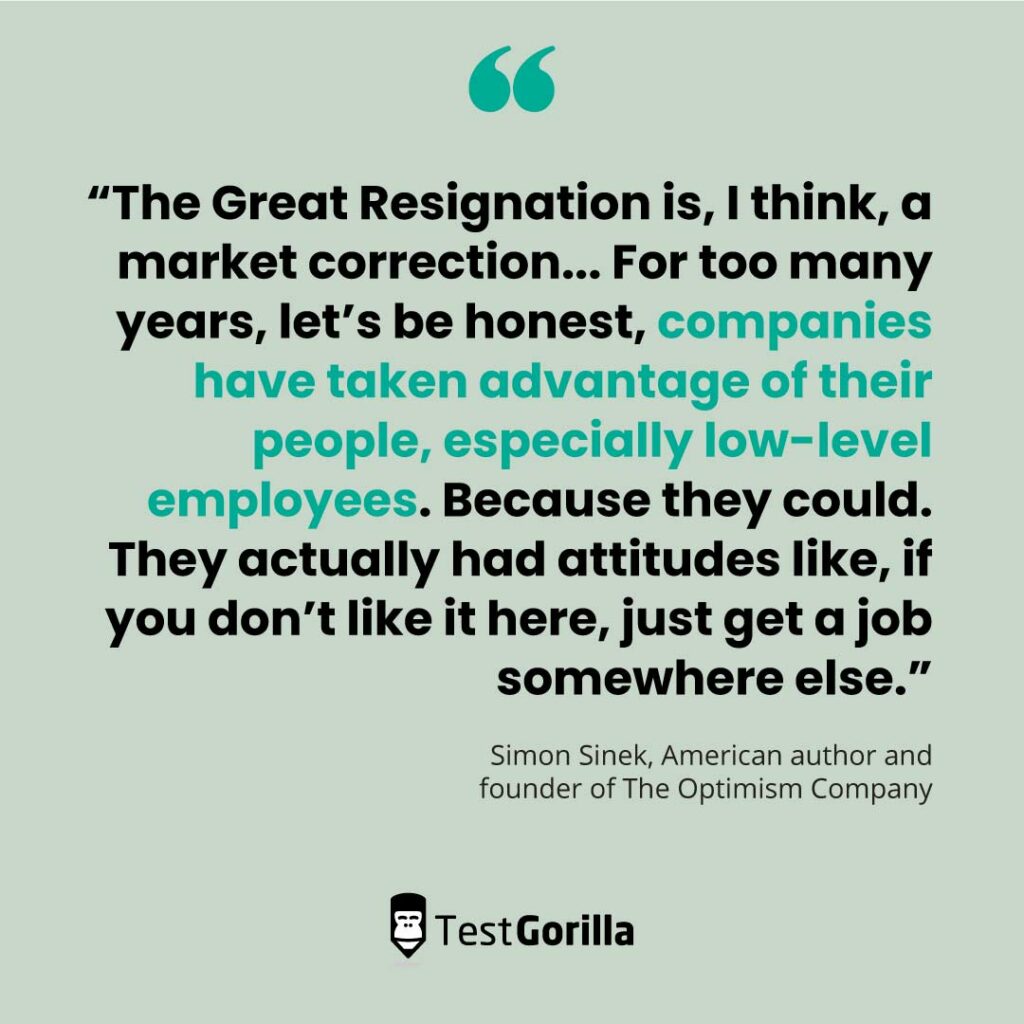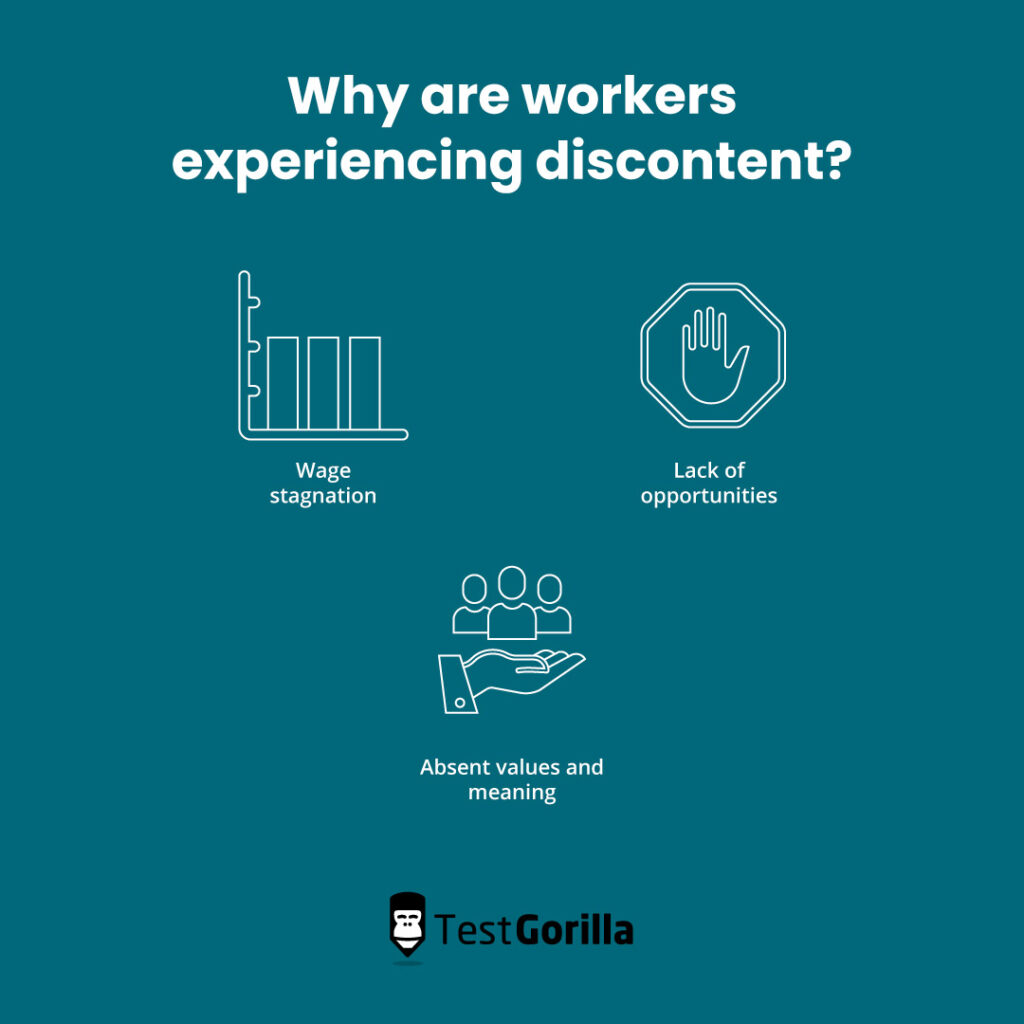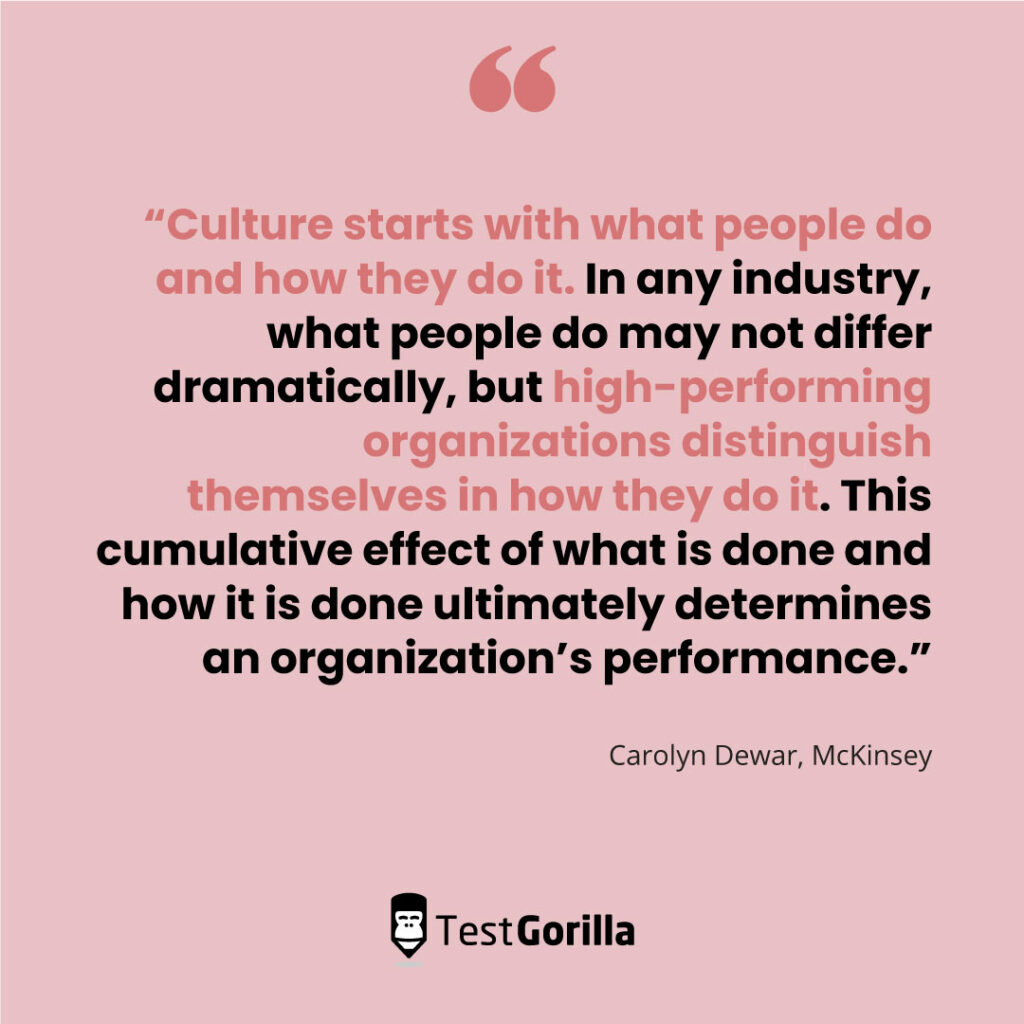These days it’s hard to keep up with the latest work-related buzzwords. There are simply too many to keep track of. Everyone seems to be quiet hiring, quiet firing, or quiet thriving. If they’re not doing quiet things then they’re rage applying or rage quitting.
That being said, there are a few buzzwords whose appearance can’t be ignored. The greats, if you will. Within the last year or so, the Great Resignation, the Great Reshuffle, and the Great Rebalancing have all been presented – in caps, for maximum impact – for our consideration and analysis.
The Great Discontent is the latest addition to this buzzy hall of fame. But what does it mean, and what should we really make of it?
As it turns out, the Great Resignation was actually a Great Reshuffle – which some saw as a Great Rebalancing – and people are now starting to realize that what we’re really seeing is a Great Discontent. So, the Great Resignation is really the Great Reshuffle, which is really the Great Discontent. Got it?
To help you keep up with this dizzying buzzword merry-go-round, we’ve deconstructed the greats. Read on to find out how the Great Resignation became the Great Discontent.
Table of contents
Firstly, a note on buzzwords
Before we dive in, we want to get you thinking about buzzwords in general, and how and why they come about.
Ultimately, they’re designed to grab our attention – this is true no matter where we consume information. Prefacing something with the word “Great,” for example, is emotive because of how the word has been used historically. Because of era-defining events like the Great Depression and the Great War, the term can function as a shortcut to our emotions and influence our feelings about a topic.
Without even realizing it, we anticipate the importance and influence of these “great” events, because the “greats” that have come before genuinely landed in the world with impact.
As we gain more and more exposure to what’s going on via the Internet, with an increasing number of news stories vying for our attention, we should be vigilant. Media platforms today are quick to label things before we even truly understand what’s going on.
As this blog post will discuss, the Great Resignation, the Great Reshuffle, and the Great Discontent all reference the same phenomena. What they represent is an evolution of our understanding of what’s going on in the world of work as increasing evidence emerges and more experts weigh in.
Buzzwords are fleeting. They denote our best attempts to understand and define a situation at any given moment in time, and that understanding may change tomorrow, next month, or in a year’s time. No matter how dramatic the headlines we’re reading make things sound, we can remind ourselves that things are always more nuanced than they seem.
Despite this, we think buzzwords are still useful. “It makes it easier for people to bring [things] up,” Coreyne Woodman-Holoubek, founder of Progressive HR, tells Worklife news. On putting great in front of everything, she says, “it’s annoying, but it does help people talk about it.”
So, with all of this in mind, let’s talk about it.
It started with a Great Resignation
In May 2021, organizational psychologist Dr. Anthony Klotz predicted a “sustained mass exodus” of workers, describing the event as a Great Resignation. Indeed, workers quit their jobs at historic rates in 2021: According to Microsoft’s Work Trend Index for the year, over 40% of the workforce were considering leaving their employer.
Experts cited a variety of explanations driving widespread resignations. The top reasons included a lack of adequate childcare, inadequate remote-work support, and health concerns in response to the rampant Omicron variant of Covid-19.
Leisure, hospitality, retail, and healthcare – all industries that require their workers to have sustained physical contact with other people – saw higher rates of resignation, further highlighting safety as a key factor. For the most part, it seemed like people were quitting in response to circumstances brought about by the pandemic.
It makes sense that workers would react this way, and there were, after all, far weirder responses to Covid-19. Take the debates about whether or not cheese, dildoes, and marijuana qualified as “essential” items; or the increase in accidental poisonings after Donald Trump suggested injecting disinfectant as a treatment for the virus.
But as we lurched into 2022, and the pandemic’s clutch on our lives began to loosen, resignation rates remained high despite predictions that they would decrease. One survey showed that almost one in five employees globally said they were likely to switch to a new employer in 2022.
A BBC worklife piece from August 2022, titled “Why workers just won’t stop quitting,” captured this dissonance. “Despite widespread predictions of a slowdown, data shows not only are people still leaving positions in spades, but many workers who haven’t yet resigned plan to do so in the coming months.”
The Great Resignation, as it turns out, was greater than we thought. And the more people analyzed it, the more it started to look like something else.
The Great Resignation begins to look more like a Great Reshuffle
With more time to assess the nature and meaning of this tidal wave of resignations, a bigger picture emerges. It turns out that more than half the workers who were quitting were changing their occupations or field of work.
Workers weren’t leaving the workforce altogether, and they weren’t simply resigning because the pandemic had made their work impossible. Many of them were resigning with the drive and intention to seek something different.
In light of this data, the Great Resignation became a label lacking nuance. Workers were changing occupations, triggering a reshuffle, and so the Great Resignation became the Great Reshuffle.
People aren’t quitting just to quit – as this became clear to those analyzing the situation, the Great Resignation didn’t seem like an adequate descriptor for the nuances of the scenario.
Many people who quit really did so out of a desire to switch to something new. For them, Covid-19 was a tipping point for action.
Covid-19 as a tipping point
Covid-19 interrupted everything we knew about work and life, giving us time to reflect on the routines we’re entrenched in as working adults.
The topic of well-being was thrown into laser focus. Being compensated fairly for your work is of course important, but what about finding connection and meaning in what you do? Leaving a job that you feel disconnected from, and finding one that gives you a greater sense of purpose, is one significant way to restore well-being.
The combined effect of time to pause and reflect, a huge increase in access to remote work, and, in 2022, a record high of 5 million more job openings than unemployed people in the US, created a climate where reshuffling your career became enticing for workers.
A year or so into the pandemic, a shift in the labor market’s supply-and-demand equation in favor of workers made leaving a job and finding a new one less daunting than before.
BBC Worklife
Simon Sinek: “What we’re actually seeing is a Great Correction”
Simon Sinek, American author and founder of The Optimism Company, had another take on the Great Resignation.
Speaking in July 2022, Sinek argued: “The Great Resignation is, I think, a market correction… For too many years, let’s be honest, companies have taken advantage of their people, especially low-level employees. Because they could. They actually had attitudes like, if you don’t like it here, just get a job somewhere else.”
He continues: “Labor workers have more influence now; thanks to Covid, people say I don’t want to be treated this way and I’d rather have no job than this job.”
For Sinek, the pandemic caused a shift in our fear of the unknown. He explains: “Prior to Covid, fear of the unknown was enough to keep somebody in an okay job. Then Covid happened, and some people were furloughed, some people lost their jobs. Some didn’t but were still filled with fear. And we made it through. So, all of a sudden, the unknown is a lot less scary, because we made it, and so when you give me ‘fine’ and you offer me ‘unknown’, I’ll take ‘unknown’.”
The root cause: Unprecedented workforce discontent
Sinek’s argument is that the pandemic has changed our tolerance for discontent. Where before workers were maybe willing to settle for a job that they weren’t that happy with, telling themselves that “it’s fine,” they now feel more equipped to seek something better and embrace what’s unknown.
There’s a large percentage of people saying “I just don’t want this, and I don’t even know what I want but it’s definitely not this.” And they’re choosing the unknown.
Simon Sinek
So, although the pandemic was a catalyst for career reshuffles, the root cause is ultimately worker discontent. Once again, our understanding of what’s going on shifts, and we begin to see an even bigger picture.
Workers are emerging from the pandemic with a sturdier sense of how much discontent they’re willing to tolerate, and a fresh willingness to reconfigure their careers and lives accordingly. For many, this meant becoming their own boss: The number of self-employed workers in the US has increased by 500,000 since the pandemic.
The Great Resignation, or the Great Reshuffle, is really about widespread dissatisfaction with work. Queue the birth of another label: The Great Discontent.
To color this with some data, research shows that resignation rates have been steadily increasing since 2009, jolting upwards more recently because of the pandemic and perhaps also 2021’s stimulus checks. In summary, reshuffling is taking place inside a landscape of worker dissatisfaction that stretches back further than we might expect.
Gen Z and quiet quitting
Writing for Forbes on the topic, Hilary DeCesare proposes her own title for widespread discontent: The Great Fed-Up Nation. She also mentions the multigenerational nuances of the zeitgeist, citing Gen Z as the leaders of the “quiet quitting movement.”
But like other buzzwords, quiet quitting doesn’t quite accommodate the bigger picture. Although Gen Z might be responsible for making viral TikTok videos on the subject, quiet quitting itself is nothing new.
Low engagement and reduced discretionary effort from employees have existed for decades, reinforcing the idea that recent mass resignations are the culmination of years of workforce discontent.
Why are workers discontent?
Wage stagnation
One of the biggest factors contributing to the Great Discontent is wage stagnation. With the cost of living rising and salaries staying the same, many employees are seeking opportunities that offer better pay.
In this economic climate, paying a fair wage is the right thing to do – but it’s also good for business. Happy employees are more productive and more likely to stay with their employer, reducing turnover and the costs associated with hiring and training new employees.
Lack of opportunities
Another contributing factor is a lack of career advancement opportunities. Many employees feel stuck in their jobs, with no hope of advancing to higher positions or increasing their salaries.
Frustration with this drives workers to seek opportunities for growth elsewhere. Employers need to provide their employees with clear paths for career advancement and invest in their professional development. Again, this will not only help retainment – it’ll help businesses to grow and succeed.
Absent values and meaning
Finally, widespread worker discontent and labor market reshuffling are signs that people want work that aligns with their values and offers more meaning to their lives.
They’re less willing to put up with jobs that they find unfulfilling, and they’re seeking different opportunities because they’re less afraid of the unknown. For many, work is no longer just a means to an end – it’s a way for them to live closer to their values and make a difference.
Employers need to concentrate on creating workplace cultures that value and support employees’ well-being and encourage meaningful work.
What’s next?
Resignation, reshuffle, or discontent? No matter which label you stick on it, the fact stands that, post-pandemic, workers have a stronger sense of what they want. And they’re more willing than ever to go and find it. But what does this mean for employers?
Companies need to double down on culture
After making his point about workers being less afraid of the unknown because of the pandemic, Simon Sinek talks about what the implications of this are for companies. “I think it’s a huge shot across the bows to most companies that haven’t focused on culture and leadership for far too long. And they better fix that, because this is ultimately an environment of their making.”
His suggestion is that companies double down on culture, working to give people a workplace that they want to go to, where they feel seen and heard, and their work contributes to something that’s bigger than themselves.
Focusing on culture makes your company more attractive to job seekers and paves the way for high performance by combating discontent. McKinsey Senior Partner Carolyn Dewar elaborates:
“Culture starts with what people do and how they do it. In any industry, what people do may not differ dramatically, but high-performing organizations distinguish themselves in how they do it. This cumulative effect of what is done and how it is done ultimately determines an organization’s performance.”
We’d distill this idea even further.
Culture starts with people. And so it follows that the decisions you make about which people to hire will make or break your culture.
Hiring intelligently is more important than ever
Like all things, the better equipped you are to make a decision the more likely you are to make it well. Unfortunately, the tools companies tend to use for hiring, namely resumes and cover letters, are as blunt as it gets. In order to double down on culture and embrace the Great Discontent to their advantage, leaders need to move away from outdated strategies.
The resume has been around since 1482 – it’s high time to move on, people.
By moving away from resume-based hiring and towards skills-based hiring practices, where pre-employment assessments are used to generate data about the skills your candidates really have, leaders can make sure they hire the right people. Hiring for culture add is a must at a time when culture is the greatest antidote to great discontent.
Related posts
Hire the best candidates with TestGorilla
Create pre-employment assessments in minutes to screen candidates, save time, and hire the best talent.
Latest posts
The best advice in pre-employment testing, in your inbox.
No spam. Unsubscribe at any time.

Hire the best. No bias. No stress.
Our screening tests identify the best candidates and make your hiring decisions faster, easier, and bias-free.
Free resources
This checklist covers key features you should look for when choosing a skills testing platform
This resource will help you develop an onboarding checklist for new hires.
How to assess your candidates' attention to detail.
Learn how to get human resources certified through HRCI or SHRM.
Learn how you can improve the level of talent at your company.
Learn how CapitalT reduced hiring bias with online skills assessments.
Learn how to make the resume process more efficient and more effective.
Improve your hiring strategy with these 7 critical recruitment metrics.
Learn how Sukhi decreased time spent reviewing resumes by 83%!
Hire more efficiently with these hacks that 99% of recruiters aren't using.
Make a business case for diversity and inclusion initiatives with this data.























